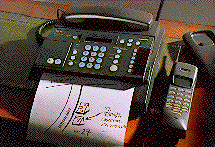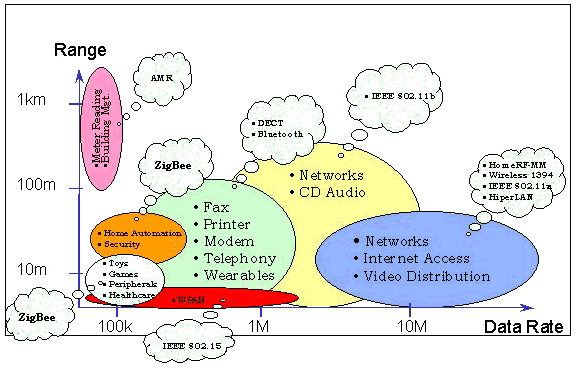
 |
JPL's Wireless Communication Reference WebsiteChapter: Network Concepts and Standards |
 With the advent of digital systems, e.g. GSM, there is a popular belief that mobile
computer communications will become easier, cheaper and better. While the
circuit quality and data rate do indeed improve, a circuit-switched channel
(supporting up to 9.6 kbit/s) is not well suited to any bursty data source,
even if using digital transmission. Furthermore, call set-up procedures in
GSM, requiring the exchange and sequentially processing of about 24 control
messages, is prohibitively long for some computer applications. With
sufficient error control, digital voice circuits are useful for transfer of
batch data such as scheduled up- or downloading of files. On the other hand,
dialling up (and paying for!) a real-time two-way circuit between end users
is quite inefficient for the more frequent modes of mobile computer
communications: electronic mail, interactive access to information services,
EDI-type computer messaging, dispatch and other types of fleet management,
and point-to-multipoint data 'broadcasting'. For the GSM packet data
services, a number of applications for Road Transport Informatics are
envisioned, such as traffic information, route guidance and fleet management.
For such applications, the network features of classical packet switching
appear desirable; i.e., non-blocking access for terminals and the ability to
convert data rates and codes within the network. Wide-area flexibility and
adaptability to serve computers and terminals with different functions and
priorities may point towards dedicated mobile packet radio networks, which
can bill by traffic volume, rather than by connect time. Such networks are
also far more economic in the use of precious radio spectrum. This is a strong
selling point in countries which charge operators for spectrum use or auction
frequencies to the highest bidders.
With the advent of digital systems, e.g. GSM, there is a popular belief that mobile
computer communications will become easier, cheaper and better. While the
circuit quality and data rate do indeed improve, a circuit-switched channel
(supporting up to 9.6 kbit/s) is not well suited to any bursty data source,
even if using digital transmission. Furthermore, call set-up procedures in
GSM, requiring the exchange and sequentially processing of about 24 control
messages, is prohibitively long for some computer applications. With
sufficient error control, digital voice circuits are useful for transfer of
batch data such as scheduled up- or downloading of files. On the other hand,
dialling up (and paying for!) a real-time two-way circuit between end users
is quite inefficient for the more frequent modes of mobile computer
communications: electronic mail, interactive access to information services,
EDI-type computer messaging, dispatch and other types of fleet management,
and point-to-multipoint data 'broadcasting'. For the GSM packet data
services, a number of applications for Road Transport Informatics are
envisioned, such as traffic information, route guidance and fleet management.
For such applications, the network features of classical packet switching
appear desirable; i.e., non-blocking access for terminals and the ability to
convert data rates and codes within the network. Wide-area flexibility and
adaptability to serve computers and terminals with different functions and
priorities may point towards dedicated mobile packet radio networks, which
can bill by traffic volume, rather than by connect time. Such networks are
also far more economic in the use of precious radio spectrum. This is a strong
selling point in countries which charge operators for spectrum use or auction
frequencies to the highest bidders.

 A
brief description of satellite systems has been compiled by Randy
Katz in Acrobat format.
A
brief description of satellite systems has been compiled by Randy
Katz in Acrobat format.
See also a discussion of early data systems in Germany.

|
The RDS or RBDS system uses FM broadcast transmissions. It provides one-way communications only. Typical applications are in paging and road transportation. |
 A
brief description of the above systems has been compiled by Randy
Katz in Acrobat format.
A
brief description of the above systems has been compiled by Randy
Katz in Acrobat format.





![]()
JPL's Wireless Communication Reference Website
©
1993, 1997.